By Charles Bausman
The Tactical Lab Rats here at MTI just concluded our 3-week Geek Cycle which consisted of four mini-studies comparing different methods of developing the following:
- Lower Body Strength
- Push Up Improvement
- Loaded Pull Up Improvement
- Power Development
Findings and Discussion
1. Lower Body Strength
Question: How do Leg Blasters compare to the Front Squat for building Low Body Strength?
Method: Both groups tested their 1-Rep Max (1RM) for the Front Squat. Group 1 continued with a percentage-based barbell Front Squat progression, while Group 2 conducted a Leg Blaster progression. Both groups re-tested their 1RM at the conclusion of the cycle. Below is the outline of the 3-week progression for each group.
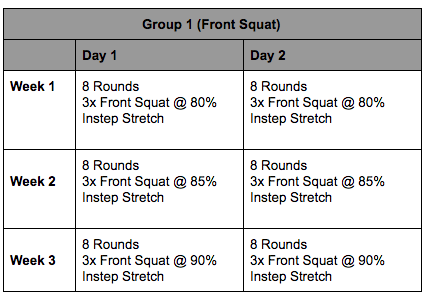
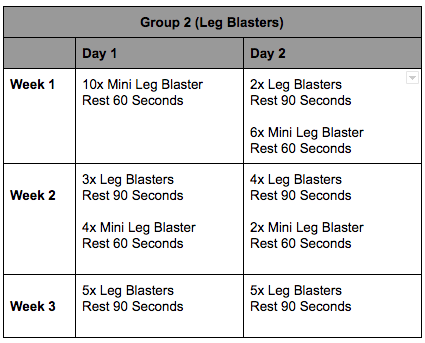
Answer: Leg Blasters were just as good for low body strength development. The results on the 1RM re-test were the exact same for both groups. All but one athlete experienced a 4% load increase on their 1RM Front Squat, regardless of if they utilized the Front Squat or Leg Blaster progression. Results below.

Discussion: Of the mini-studies completed in this Geek Cycle, we were most interested in the results of this one. If an athlete wants to get stronger, the answer has been to simply get them under a barbell with a heavy external load. This mini-study provides evidence that while the barbell works, a low-body complex may work just as well. From a programming perspective, training strength means you need access to a fully-equipped gym. This may provide a viable option for those training in austere environments or simply without access to a gym. It also validates our use of Leg Blasters in our Running Improvement Plan, Limited Equipment plans, etc.
Next Steps: Would the Quadzilla Complex work more efficiently in building low-body strength compared to a Back Squat or Box Squat? How does a “high training age” effect strength improvement versus “low training age” between these exercises?
2. Push Up Development
Question: How does the MTI percentage-based density progression compare to a high volume progression for overall push up improvement?
Method: Both groups tested max push ups in 2 minutes. Group 1 employed our percentage-based density progression. Group 2 employed a high volume (2x total rep-volume compared to the density method) progression with a traditional set/rep scheme. Both groups re-tested max push ups at the conclusion of the cycle. Below is the outline of the 3-week progression for each group.
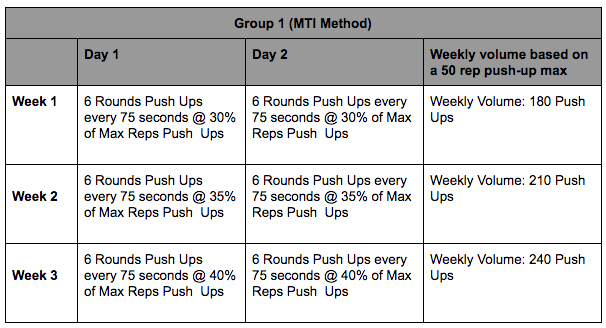
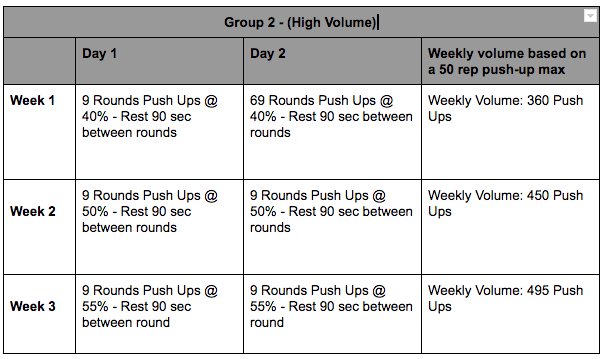
Answer: Similar improvement results between both methods, but the density progression is more efficient. Both groups had an outlier in results, including one athlete in Group 1 whose results decreased and one new athlete who had a dramatic jump. Results below.

Discussion: Group 2’s high volume approach took much longer to complete during a training session, usually right around 20 minutes total. The density format takes exactly 7:30 min and therefore appears to be a much more time-efficient approach for push up improvement. In addition, the toll of Group 2’s high volume approach was apparent in the Lab Rats. They reported muscle and joint soreness, while Group 1 did not.
Next Steps: Could we employ an even lower volume push up approach by increasing the external load or resistance? How would different variations of the push up (clapping push ups, hand release push ups) affect overall improvement?
3. Loaded Pull Up Improvement
Question: How does the MTI percentage-based density progression compare to heavy eccentric pull ups for overall pull up improvement?
Method: Both groups tested max pull ups with a 25# load. Group 1 employed our percentage-based density progression. Group 2 employed eccentric pull Ups at a 50# load with the same percentages for reps, but in a traditional set/rep scheme. Both groups re-tested max reps pull ups at 25# at the conclusion of the cycle. Below is the outline of the 3-week progression for each group.
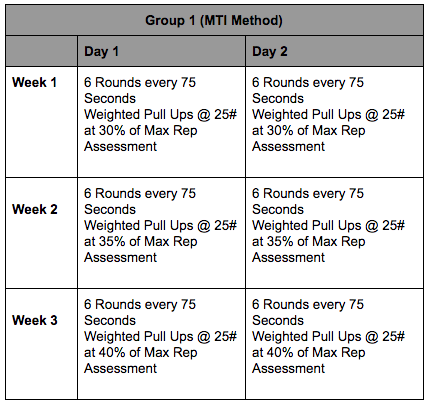
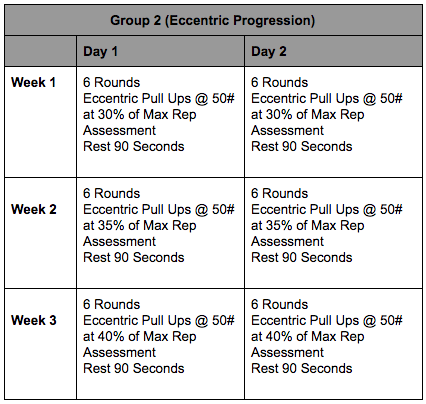
Answer: Both groups again reported similar increases. The load-volume and time to complete training were significantly less for Group 1, therefore providing a potentially more efficient method, but not necessarily better for overall improvement. Results below.
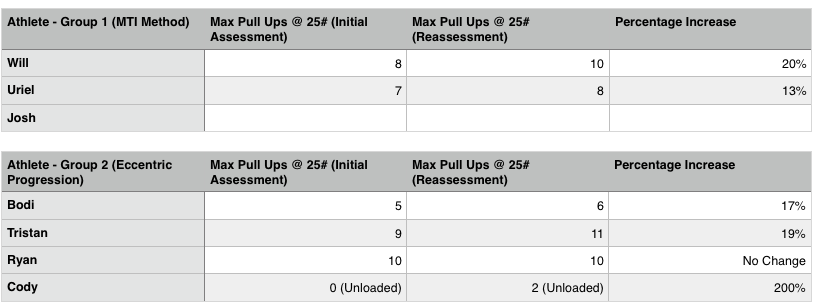
Discussion: MTI has studied Pull Up improvement multiple times, and the results seem to remain constant. Different variations of pull up progressions all work for improvement, but no one method stands out as superior to others. For those with poor upper body pulling strength, eccentric pull ups do provide an excellent way to train the fitness attribute.
Next Steps: Eccentric pull ups work well for athletes with poor upper body strength. How does it compare to assisted pull ups, such as a with a large band underfoot or partner assisted repetitions?

4. Power Development
Question: Is an explosive exercise better than lower body strength exercise for power development?
Method: Both groups tested their max standing broad jump. Group 1 completed a traditional lower body strength progression with the Hinge Lift. Group 2 employed a loaded barbell Squat Jump progression with lightweight in a power density progression. Both groups re-tested their max standing broad jump at the conclusion of the cycle. During week 2, we increased the load for Group 2’s Squat Jumps to 85# due to the ease at which athletes were able to jump with the 75# barbell. Below is the outline of the 3-week progression for each group.
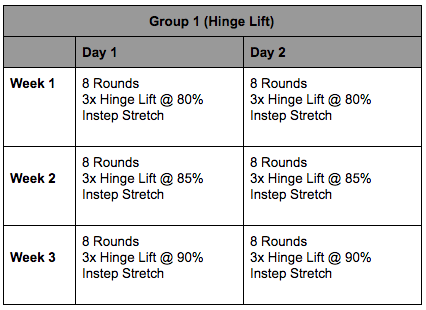
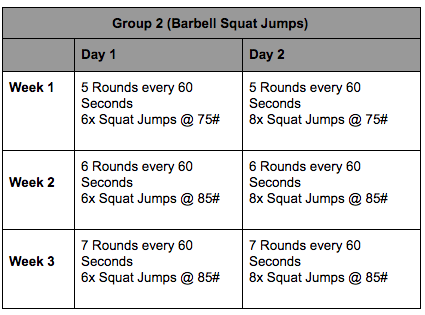
Answer: Remains unclear. Both groups reported similar increases in their standing broad jump assessment. Results below.
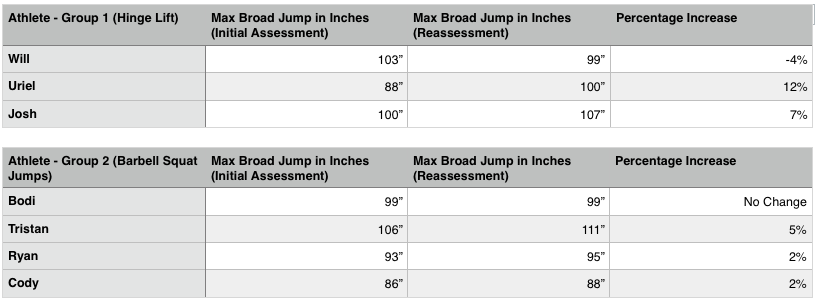
Discussion: Power remains one of the most challenging attributes to test. Power lifts such as the multiple variations of the clean provide an easy metric (amount of weight moved) but are technique dependent. A vertical jump or broad jump is also easy to measure, but involve a degree of athleticism which may skew results. It is interesting that a “slow” lift such as the Hinge generated an increase in two of the three athletes with Group 1, but the results were simply not consistent enough to draw a conclusion from.
Next Steps: Go back to the drawing board on how to measure power without technique or athletic variables. We’re currently working on equations to measure this through other exercises and time domains… it’s a tough nut to crack. More to follow.
Conclusions and Thoughts Going Forwards
This first iteration of the Geek Cycle was an interesting way to search for holes in our own programming. The testing procedures would likely be frowned upon by academia, but we’ve found that testing with our lab results is indicative of the efficacy of our methodologies. We’re able to find Mission Direct answers (or questions) very quickly, while an academic study might take many months to conduct and publish.
For tactical athletes, we’re focused on creating strength and conditioning programming which is effective and time-efficient. The four mini-studies in this Geek cycle allowed us to generate information for further testing and evaluation which will migrate into our daily and event-specific programming.
Questions/Comments/Feedback? Email coach@mtntactical.com
You Might Also Like Are You Strong Enough? Take The MTI Relative Strength Assessment
STAY UPDATED
Sign-up for our BETA newsletter. Training tips, research updates, videos and articles - and we’ll never sell your info.
